As part of our ongoing Q&A series, I thought I’d address one of the most common questions we get: Do we ever wish we could have more physical contact with the chimps?
As many of you know, we strictly limit the ways in which we interact with the chimpanzees out of concern for our safety. Chimpanzees are incredibly fast and powerful animals with large, muscular jaws and massive canine teeth. Estimates vary, but it’s safe to say that chimpanzees possess at least twice the upper body strength of humans, pound for pound. And for chimpanzees, aggression is not an aberration but rather a normal part of the way they interact with one another and the world around them.
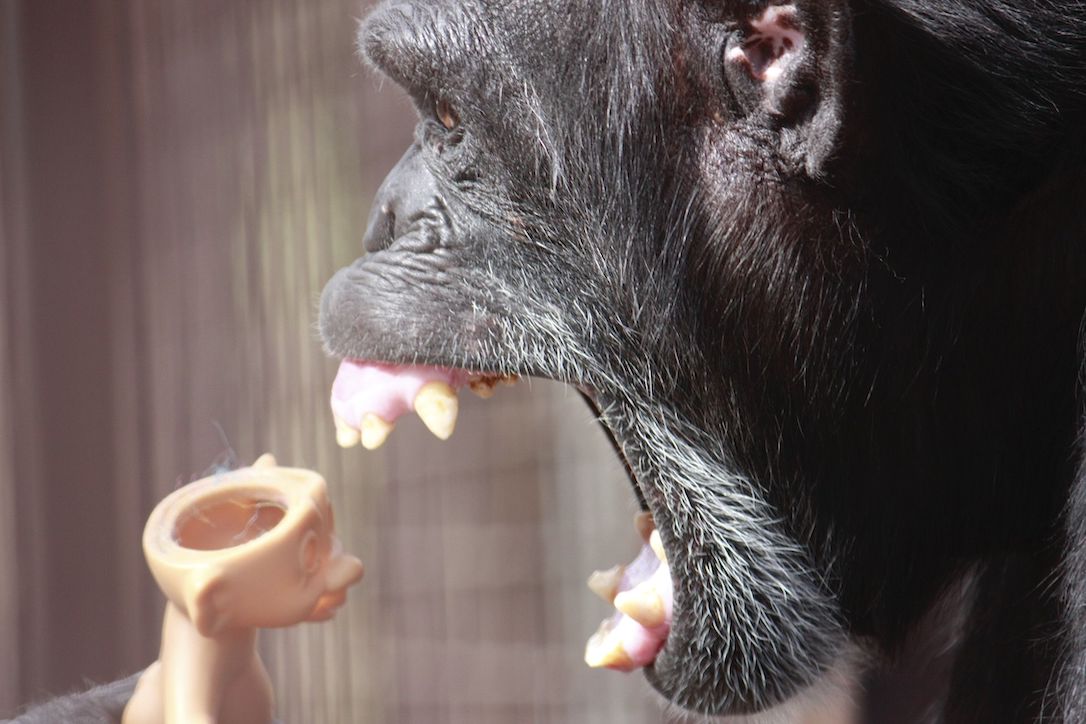
Compounding the risk posed by their strength and natural behavior is the frustration they experience in captivity. One of the profound ironies of caring for chimpanzees is that you are far safer strolling through an African forest amidst a community of over a hundred free-living chimpanzees than you are standing near the enclosure of a captive chimpanzee. In fact, when Jane Goodall, the world’s foremost expert on chimpanzees, lost the tip of her thumb, it was not to one of the chimpanzees of Gombe that she had spent decades living among but rather to a chimpanzee in a laboratory cage. Frustration is not limited to chimpanzees in laboratories, however. Even in the best zoos and sanctuaries, we deny chimpanzees control over their lives and the ability to make choices for themselves. To put it bluntly, all captive chimpanzees are prisoners to varying degrees and we should not be surprised when they occasionally act as such.
So if we are concerned with safety, we’re left with a cautious and largely hands-off approach to caring for captive chimpanzees. In those times when we do have contact, we do so through the mesh fence in very controlled ways. We like to use the term protected contact, which originated as a way to describe the safe management of elephants from behind a safety barrier. At CSNW, this means that our bodies never penetrate the caging. If the chimps want us to touch them, we do so with the tip of a knuckle while the chimps press their bodies against the mesh. If they want to touch us, they must extend their fingers all the way out and we limit their reach to our bare elbows or wrists. These methods, along with countless hours of training, help limit opportunities to get bitten or grabbed.
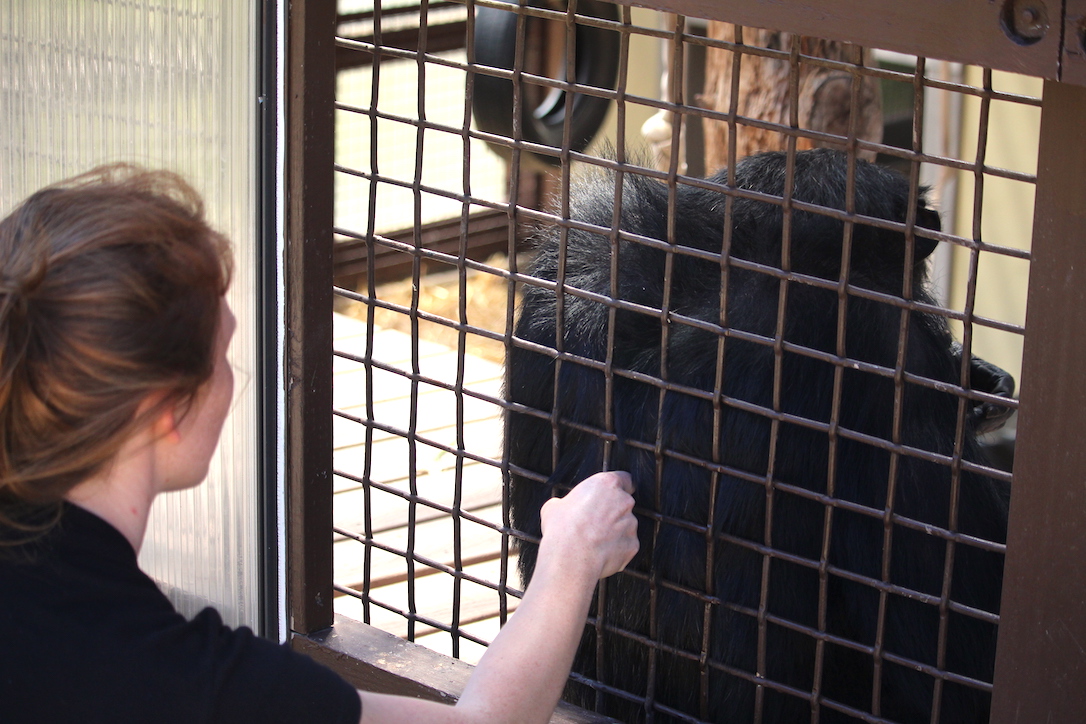
All of this eventually becomes second nature for both caregivers and the chimpanzees and I can honestly tell you that I rarely desire to have more contact with my chimpanzee friends. That said, I do remember feeling differently during my first summer spent around chimpanzees. In 1998, I was an apprentice at the Chimpanzee and Human Communication Institute, and my fellow apprentices and I would spend five or more days per week recording observational data on the chimps, cleaning near them, and coding videos of them. Our lives were consumed with chimps but we were not trained to a level where we could have any contact with them at all. It was killing us. So much so that when we’d be out on the town at night, we’d inevitably mob some unsuspecting dog and frantically pet them until they managed to break free and run for help.
There is one particular situation where it is relatively safe for us to have free contact with the chimps and where we do sometimes indulge ourselves, and that is when they are under anesthesia for medical care. In these moments, in between the IV prep and the blood pressure readings, we sometimes find ourselves holding their hands. Maybe it’s in the hopes that somewhere in the deep recesses of their subconscious they can sense that we are there with them. Or maybe we are looking to them for comfort.
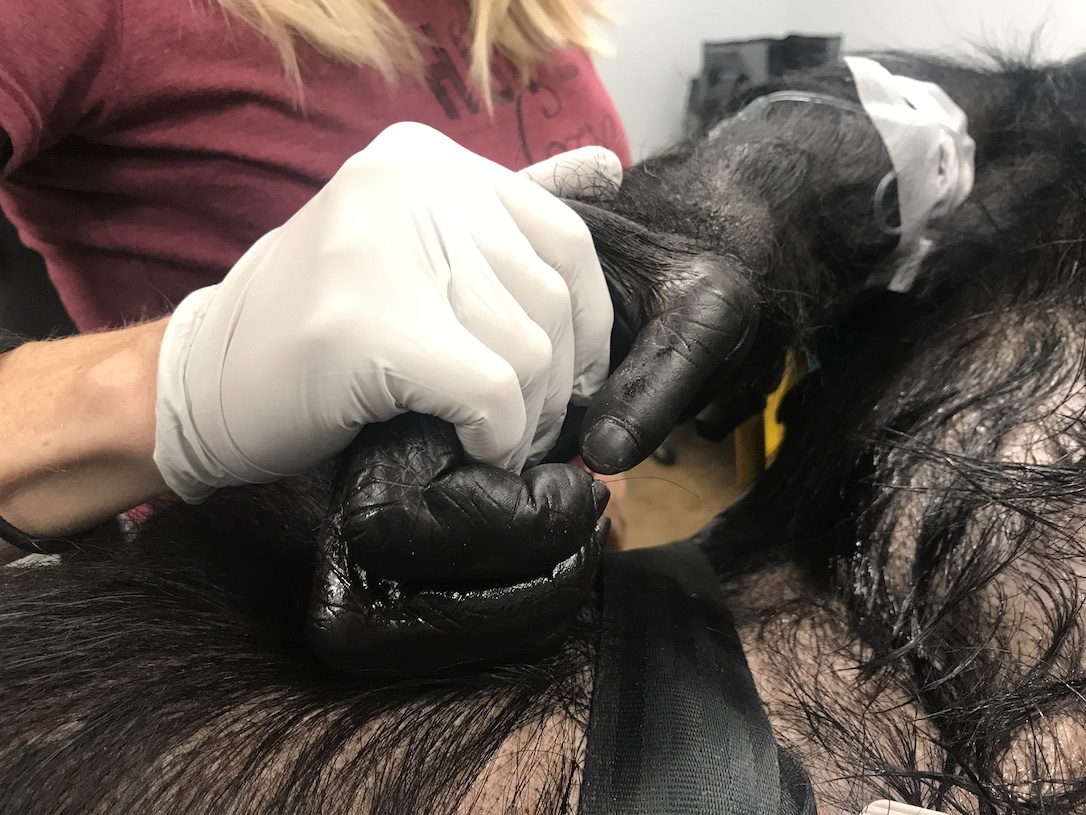
It’s important to remember that in normal circumstances the chimpanzees in our care get all the hugs, snuggles, play slaps, and tickles they desire from their chimpanzee friends, and the chimps and their caregivers are able to develop rich and full relationships despite the physical separation. It’s only natural to want to have more physical contact with them, but eventually you come to realize that a raucous game of chase across the mesh barrier is a perfectly fine way for two friends to play. No physical contact needed.
And in those times when we need a good ol’ hug…well, that’s what dogs are for.
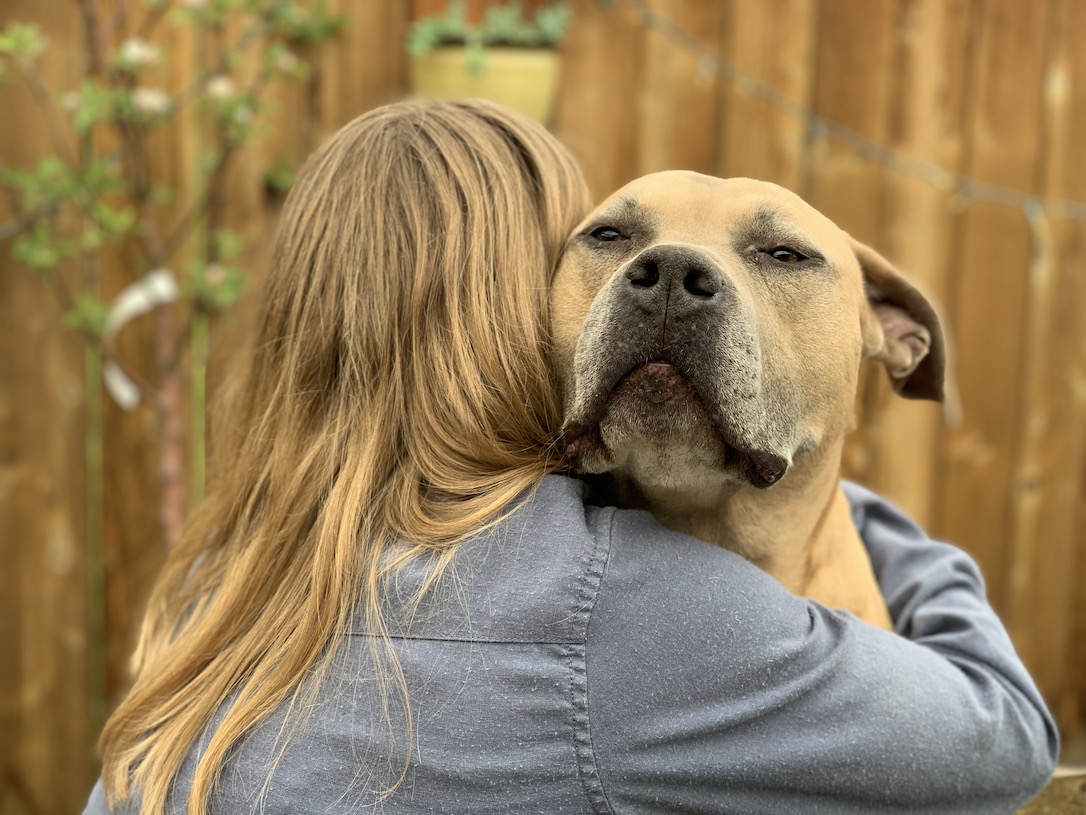
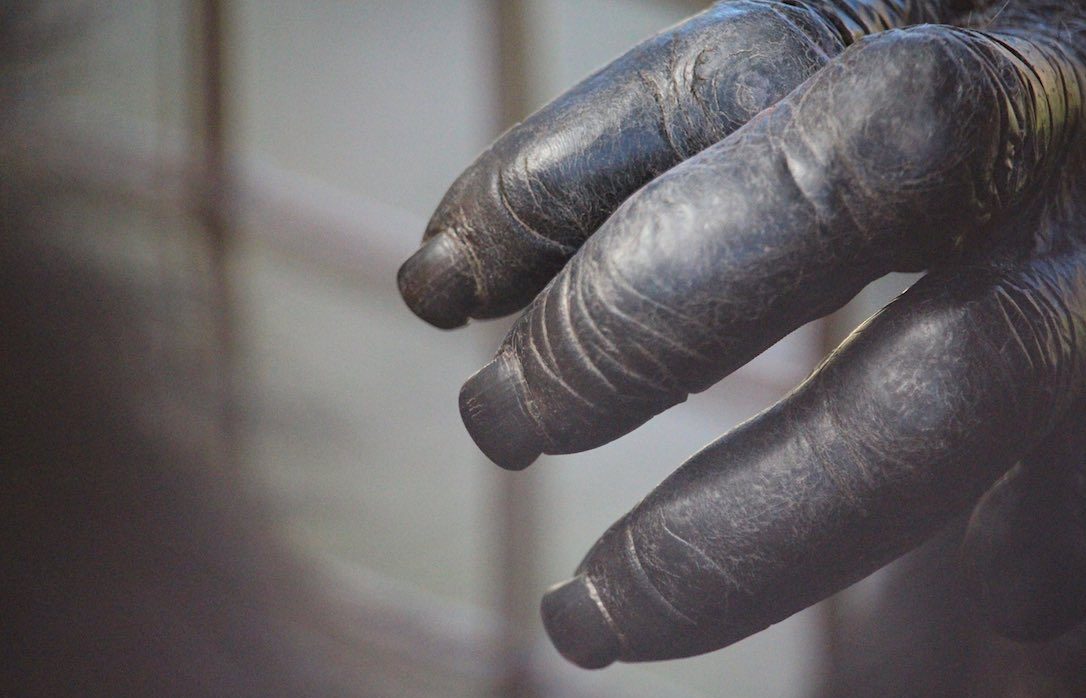





Thank-you for this interesting explanation.
Another excellent post from your bag of questions, thank you. Now there’s no need for me to ask why so many of the trolls have lost their hair. : ) I do love that photo of Diana holding Mr. B’s hand and I’d like to think deep down he could feel it and found comfort in the connection. And I would be first in line for a hugging session with handsome Wilson!
“The chimps need each other more than they need us” (or words to that effect), I once read on a blog written by Diana. Fascinating and endearing as chimpanzees are, there are a few eons of evolutionary divergence between those primates and their weaker mutations (a/k/a human animals). As I recall reading of the tragedy of Travis, a chimpanzee who was kept as a housepet in a Connecticut city, “He was just like one of us, until, one day, he reminded everyone that he wasn’t.” Thus, the barriers between the two primate species are necessary. It will have to suffice for Burrito and Negra to provide their needs for hugs with members of their troglodyte troop.
As an alternative for the select humans who habituate the periphery of Young’s Hill, fortunately there are mammals such as Wilson the Wonder Dog who can provide hugging services. Speaking of whom, do Wilson and Abby ever join their human friends with walks about the fence of Young’s hill? If so how do the chimpanzees react? For that matter, do the dogs pay visits to the cattle? I’m just curious.
Excellent question Tobin about Abby and Wilson. I have always wondered if the dogs ever join in for a perimeter walk once in a while. And I am curious about them meeting the cattle too, even if just on the other side of the fence, especially since the winter pasture is close to their own backyard. At the farm rescue where I volunteer the shelter dogs who can contain themselves : ) like to visit the cows and both species are very curious about each other, especially the younger calves.
Hi Tobin and Kathleen:
Wilson and Abbey are both reactive dogs. Obviously, this is solely due to their histories prior to being rescued and has nothing whatsoever to do with our dog training skills 🙂 Over time they have gotten better but their presence around the chimps has the potential to cross from enriching to stressful depending on everyone’s mood. So we don’t walk them around the hill very often. The chimps all have different responses to dogs regardless of the dog’s disposition. For example, Annie has never liked dogs, whereas Missy generally likes to play chase with them. Jamie also likes to race us and the dogs down the hill.
The dogs and the cows share a portion of a fence line, and at first this caused a bit of a commotion. Abbey barks incessantly, and Betsy would respond by charging around the pasture. After a few weeks of occasional confrontations like this, they both learned to ignore each other. Nutmeg and Honey don’t seem to care, and Meredith isn’t aware of what’s happening until 10 minutes after everyone else so she tends to miss out on the action.
Our first dog, Honey B, was a bit of handful as well. After she passed away, I dreamed of rescuing the quintessential “farm dog” who could hop in the truck for a ride into town or tag along while we were fixing fences. But our rescues choose us, and of course we find loads of charming qualities in them that we hadn’t even imagined. So Abbey and Wilson are mostly restricted to their fenced-in orchard or walks on a leash around the outskirts of the property. I think the deer are happier that way, anyway.
Thank you. I often wondered how the humans felt about not touching the chimps. I would think it would be darn hard not to, but I also feel we owe them that respect. Plus I would like to keep my fingers! So what about the situations where children fall into gorilla enclosure. I mean the chimps know you guys so well if you were to accidentally get trapped on the other side with them would you be scared? I know that that could never happen you guys are so good about your safeties but what if?
I was in a situation in Africa where I had a chimp pass me on the trail and he touched my leg, thrill of a lifetime for sure. I get the difference that you’re talking about….. cage versus free. A whole other Dynamics.
Hi Jo: Yes, I would certainly be scared. Usually, that type of accident concludes without any injuries. Quite often, the chimps just want everything to get back to normal, whether they’ve escaped or someone has found their way into their enclosure. But this is not always the case, and you won’t know until it happens. So part of our training includes how to react in the event of an incident like this. In addition to frustration, fear will often lead to increased aggression. That’s why we also train folks to know how to act non-threateningly and diffuse potentially dangerous situations should they occur.
I LOVED this! Having worked as a professional with a variety of captive wildlife (but no chimps….gorillas and orangs, yes) for over 30 years, your article was spot on!! I could not find anything that wasn’t. You are the epitome of caring, loving, concerned, thoughtful and understanding caretakers that have the chimps health and welfare at the forefront, along with your own. Kudos to your organization and to all of you under their umbrella.
Thank you for this blog post. Very touching and informative. Gosh, that photo of holding Burrito’s hand! So sweet!
This is another post that shows your depth of love for the chimps and sense of humor. Thanks again to everyone for your care and dedication.
Thanks, JB, for answering a while bunch of questions that I didn’t even know I wanted answers for. That last picture of Diana and Wilson brought a flood of tears. Missing my Ricky so much these days when having a dog during isolation is so heartbreaking. Hardly get through a day without crying even though it was 17 months ago that he left me. Loved the picture of Diana holding Bubba’s hand. TOUCHING those you love is such a needed human need. I think this asking questions for all of you was such a fabulous idea, Diana.
Thanks again, JB. I had always understood the safety issues, but it’s good to hear that the desire to cuddle with them wears off after a while. Your description of your student days reminds me of why Student Activities often schedules a pet therapy day for students, when dogs and cats (and goats, etc) are welcomed to come and give the students a chance to snuggle, especially those who are missing their pets at home (seriously, when I ask them what they miss most about home, many list their pet first, siblings second!)
And the troll doll caption had me laughing out loud! (Random idea for future: post a pic, have us write our captions).
This was an excellent reply! Thank you. People always ask me if I get to “touch” and “play” with the animal and while the answer is sometimes yes it is in a very different way than with a domestic animal. Always in a protected setting. Always the animals choice. Your explanation was spot on and perfect!
Thanks J.B… what a great explanation. And indeed Diana holding Mr.Bs hand is beyond touching – I personally am absolutely certain that there was comfort from that reaching his subconscious. And the Wilson/Diana hug is so precious. We all need that hug. 🙂